There’s something magical about cooking under the open sky—the crackling flames, the fresh air, and the joy of sharing a meal with loved ones. Whether you’re a seasoned outdoor enthusiast or planning your first trip, quick and tasty dishes can make the experience even better.
I still remember the first time I grilled foil-wrapped veggies and sausage over glowing embers. The flavors were incredible, and cleanup was a breeze. That’s the beauty of outdoor cooking—simple ingredients transform into something unforgettable with just a little heat and creativity.
From hearty one-pan meals to sweet treats like campfire cones, these ideas balance speed and flavor. No need to spend hours prepping—just gather your ingredients, fire up the grill, and enjoy. Perfect for summer nights or a spontaneous weekend getaway!
Table of Contents
Key Takeaways
- Quick outdoor meals save time without sacrificing taste.
- Foil packets are versatile for proteins and veggies.
- Desserts like toasted marshmallow treats add fun to any trip.
- Ideal for families or solo adventurers.
- Minimal cleanup lets you focus on the experience.
Why 30-Minute Campfire Meals Are a Game-Changer
Camping meals have evolved far beyond basic hot dogs—today’s recipes are quick, flavorful, and fuss-free. After a long day exploring the great outdoors, you want a hearty meal without the hassle. That’s where 30-minute campfire cooking shines.
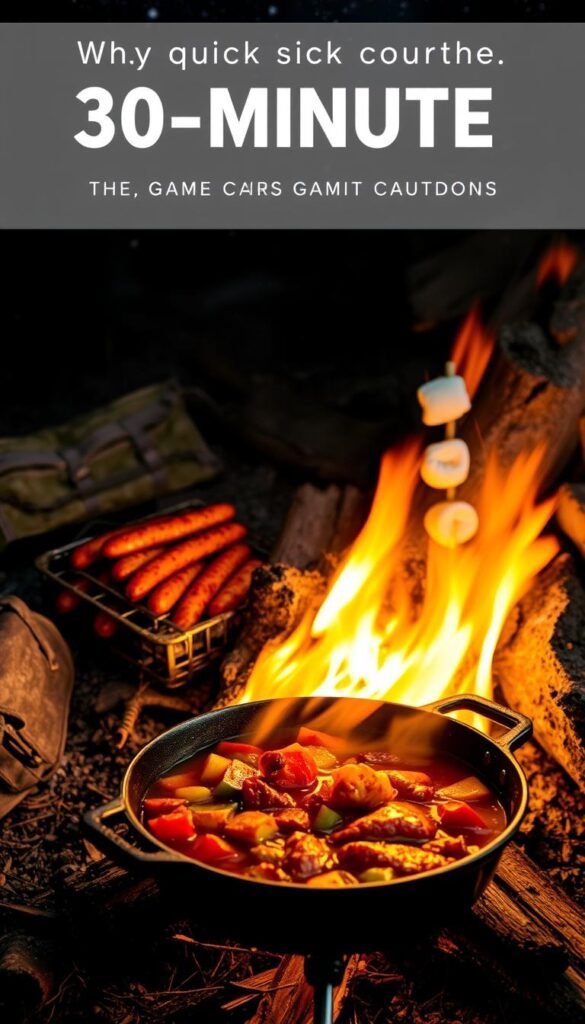
I learned this the hard way on a weekend camping trip. Traditional cast-iron skillets weighed down my pack and required scrubbing. Foil packets, though? They glow like edible treasure chests—locking in juices, speeding up cook time, and leaving no mess behind.
Here’s why they’re revolutionary:
- Speed: Hungry after a hike? Dinner’s ready before the fire needs stoking.
- Versatility Swap proteins or veggies based on what’s fresh—or what survived the cooler.
- Weatherproof: Wind or rain won’t ruin your meal when ingredients are snug in foil.
On multi-day trips, saving energy matters. Foil packets cut prep time in half, leaving you free to fish, stargaze, or just relax. Plus, cleanup is as easy as crumpling foil—no greasy pans or leftover crumbs to attract wildlife.
Modern campfire classics prove that fast food doesn’t mean bland food. With the right recipes, you’ll savor every bite—and still have time for s’mores.
Top 5 Campfire Recipes You Can Make in 30 Minutes
Nothing beats the aroma of food sizzling over an open flame—especially when it’s ready in half an hour. These foil packet recipes turn simple ingredients into memorable camping dinners with minimal effort. I’ve tested each one on countless trips, from lakeside picnics to mountain hikes.
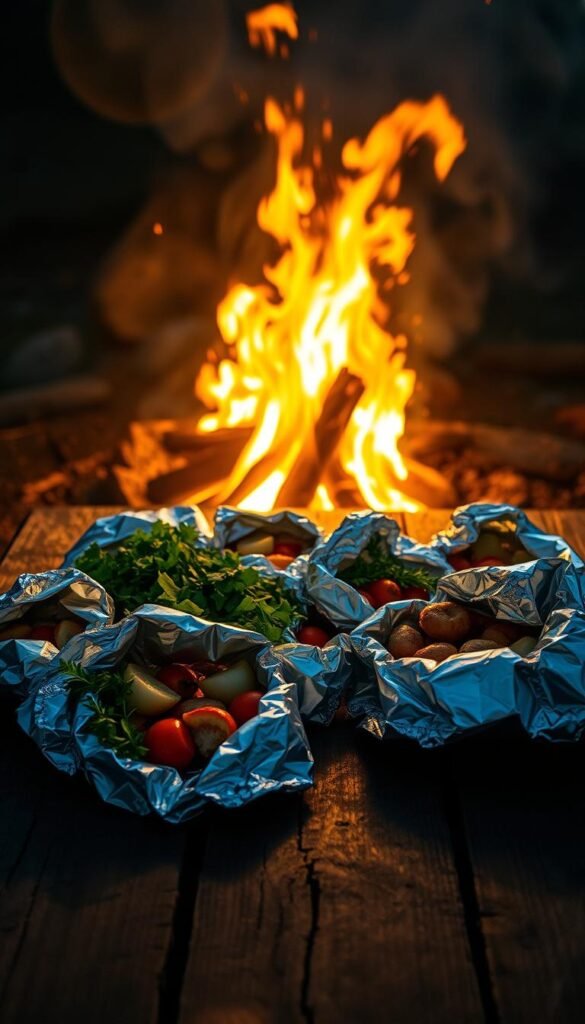
Lemony Salmon and Asparagus Foil Packets
Bright citrus flavors shine in this easy recipe. Place fresh salmon fillets on a bed of asparagus, drizzle with olive oil, and top with lemon slices. Seal tightly in foil—the steam keeps everything tender. Cook for 15-20 minutes near hot coals.
- Pro tip: Add capers or dill for extra zest.
- Swap trout or cod if salmon isn’t available.
Southwest Chicken Foil Packets
Smoky and satisfying, these packets combine chicken thighs with Rosarita black beans, corn, and bell peppers. A sprinkle of taco seasoning ties it all together. Fold into a foil pack and grill for 25 minutes.
- Use pre-cooked rotisserie chicken to save time.
- Top with avocado or Greek yogurt after cooking.
Shrimp Scampi Foil Packets
Garlic-butter shrimp cooks perfectly in its own sauce. Toss with linguine or zucchini noodles before wrapping. The grill infuses a subtle smokiness—just 12 minutes over medium heat.
- Add red pepper flakes for heat.
- Mark packets with colored markers to track spice levels.
Campfire Cones (Dessert)
Kids love assembling these sweet treats. Fill waffle cones with marshmallows, chocolate chips, and berries. Wrap in foil and warm for 5 minutes until gooey. Discover more creative camping recipes for inspiration.
Kielbasa & Potato Foil Packets
Hearty sausage pairs with golden potatoes and onions in a honey-mustard glaze. Double-layer the foil for even cooking—about 20 minutes per side. Perfect for chilly evenings.
- Try sweet potatoes or parsnips for variety.
- Add a splash of beer for deeper flavor.
Each recipe adapts easily—use what’s in your cooler or try vegetarian versions. The real magic? Crumpling up the foil when you’re done, leaving more time for campfire stories.
Essential Gear for Fast Campfire Cooking
Efficiency outdoors starts with smart gear—lightweight, multi-purpose, and built to handle flames. After years of trial and error, I’ve learned that the right tools transform chaotic meal prep into seamless fun. Whether you’re a minimalist or a gourmet camper, these picks balance durability and convenience.

Cast Iron Skillet vs. Foil Packets
A cast iron skillet excels for searing and even heat, but it’s heavy. Foil packets, meanwhile, are featherlight and disposable. Here’s how they compare:
- Heat Retention: Cast iron stays hot for slow-cooked dishes like caramelized onions or Dutch oven cobblers.
- Speed: Foil cooks faster—ideal for delicate proteins like fish or quick veggie medleys.
- Cleanup: Foil wins. Just crumple and recycle (pack it out!).
Must-Have Utensils
Skip flimsy tools. These survive the fire and pack flat:
- Locking Tongs: Flip foil packets without dropping dinner into the coals.
- Silicone Spatula: Scrapes every bite from a skillet without scratches.
- Collapsible Grill Basket: Perfect for veggies or small items that fall through grates.
My personal favorite? Heat-resistant gloves—no more singed fingertips when adjusting logs.
How to Customize Foil Packet Recipes
Foil packets are like blank canvases—endlessly adaptable to whatever flavors inspire you. I’ve turned them into everything from zesty Thai curries to smoky BBQ feasts just by swapping a few ingredients. The key? Treat them as a mix-and-match game where creativity wins.

Flavor themes make customization easy. Try Mediterranean with olives, feta, and oregano, or go Tex-Mex with black beans, corn, and chili powder. For Asian-inspired camping meals, toss shrimp with soy sauce, ginger, and sesame oil before wrapping.
Seasonal veggies keep things fresh. In summer, I pack zucchini and cherry tomatoes. Fall calls for sweet potatoes and Brussels sprouts. Just chop evenly so everything cooks at the same rate.
Cheese lovers, listen up: Add toppings like cheddar or goat cheese after cooking for perfect melts. Or tuck a slice inside foil packet folds to create a crispy, golden crust.
Proteins are flexible too. Swap sausage for tofu or tempeh—marinate first for extra flavor. Pre-make sauce packets (think pesto or tzatziki) in small containers to drizzle post-grill.
My favorite trick? DIY spice blends. Mix smoked paprika, cumin, and brown sugar for a rub, or combine lemon zest with herbs de Provence. Store them in tiny jars to label each recipe.
Campfire Safety Tips for Efficient Cooking
A well-managed fire is the heartbeat of any great outdoor meal—control it, and you control the feast. I learned this the hard way when a gust of wind sent flames licking at my grill, charring dinner to a crisp. Now, I plan every campfire layout like a chessboard, with zones for searing, simmering, and safety.
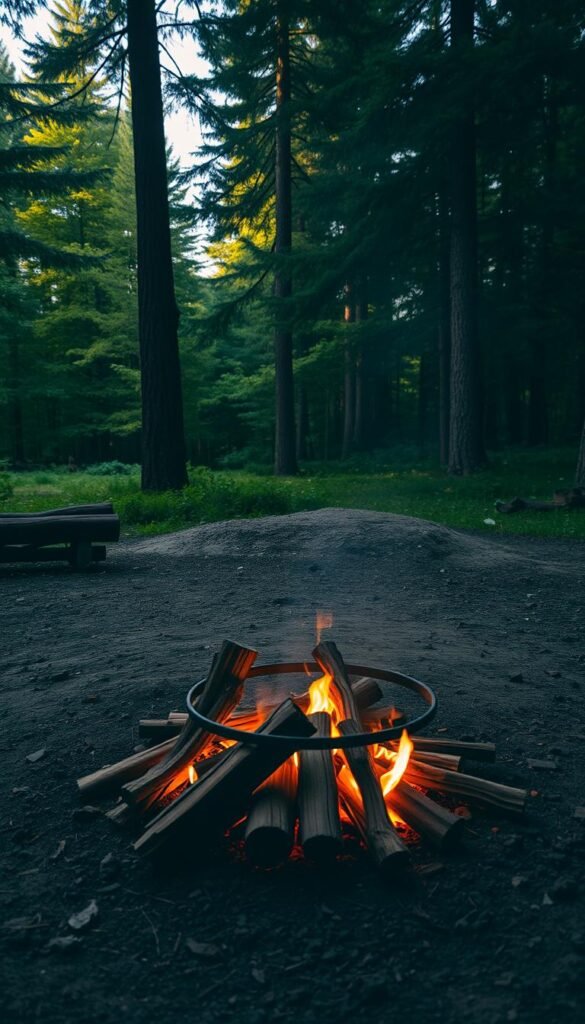
Managing Heat Zones
Think of your fire as three distinct areas:
- Hot zone (direct flames): Searing meats or boiling water.
- Medium zone (glowing coals): Even cooking for foil packets.
- Cool zone (edge of pit): Keeping finished meals warm.
Test heat levels with the hand test—hold your palm 6 inches above coals. If you pull away in 2 seconds, it’s hot; 4 seconds means medium.
Fire Extinguishing Basics
Always keep a bucket of water or fire blanket nearby. For my family, I pack a mini extinguisher—it’s saved us from flare-ups when grease dripped onto logs. Remember: Never bury flames with dirt; smoldering embers can reignite hours later.
Wind direction matters too. Set up your grill perpendicular to the breeze to avoid uneven heating. On my last trip, shifting winds turned my foil-wrapped trout into a smoky mess—lesson learned!
Pro tip: Designate a “cool zone” with a flat rock or metal tray. Move finished packets here to prevent overcooking while you prep the next camping course. Safety isn’t just rules—it’s the secret to savoring every bite under the stars.
Vegetarian and Vegan Adaptations
Plant-based camping meals can be just as hearty and flavorful as their meaty counterparts—if you know the right tricks. I discovered this during a week-long trip with vegan friends, where we transformed simple ingredients into unforgettable camping recipes. The key? Smart protein swaps and bold seasoning.
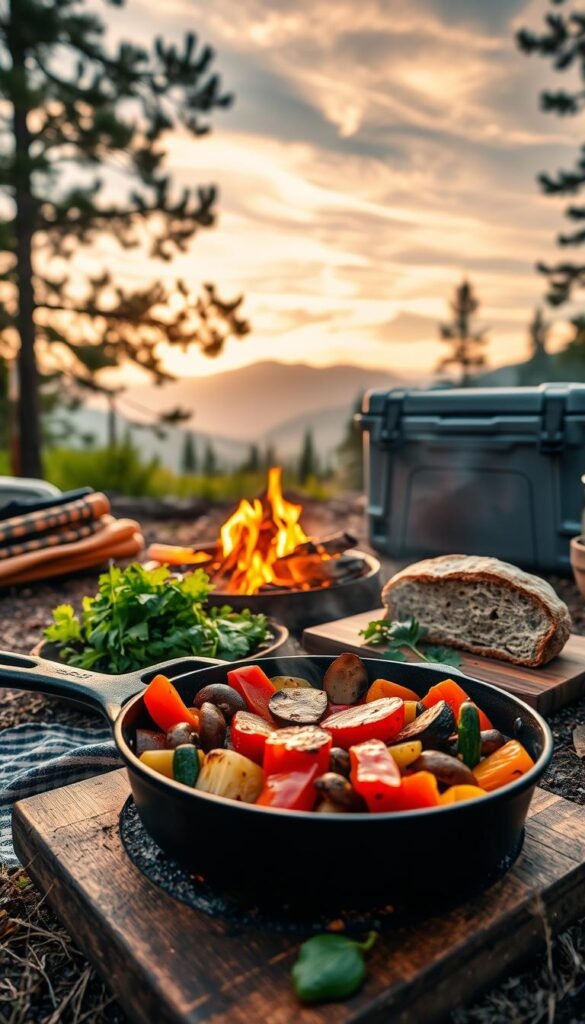
| Meat Alternative | Best For | Prep Tip |
|---|---|---|
| Extra-firm tofu | Kebabs, foil packets | Press for 30 minutes first |
| Jackfruit | Pulled “pork” sandwiches | Shred after grilling |
| Seitan | Steaks, skewers | Marinate overnight |
| Lentils | Chili, burgers | Pre-cook at home |
Marinating makes all the difference. For tofu, try a mix of soy sauce, maple syrup, and smoked paprika. Jackfruit soaks up BBQ sauce like a sponge—perfect for summer cookouts. I always pack small jars of pre-mixed marinades to save time.
Vegan cheese melts best when added at the end. Nutritional yeast makes a great Parmesan substitute for toppings. For gooey nachos, use a blend of cashew cream and tapioca starch.
High-protein veggie combos keep energy up:
- Quinoa + black beans + sweet potatoes
- Chickpeas + cauliflower + tahini
- Edamame + mushrooms + brown rice
For breakfast, flax eggs (1 tbsp ground flax + 3 tbsp water) work wonders in foil-pack scrambles. Brands like Beyond Meat and Lightlife grill well—just oil the food lightly to prevent sticking.
These ideas prove that plant-based meal prep can be simple, satisfying, and full of flavor. The best part? Everyone at the fire pit will be asking for seconds.
Kid-Friendly Campfire Meal Ideas
The secret to stress-free family camping meals? Letting little hands help with the cooking. I’ve watched kids devour veggies they’d normally refuse—just because they arranged them in foil packets themselves.
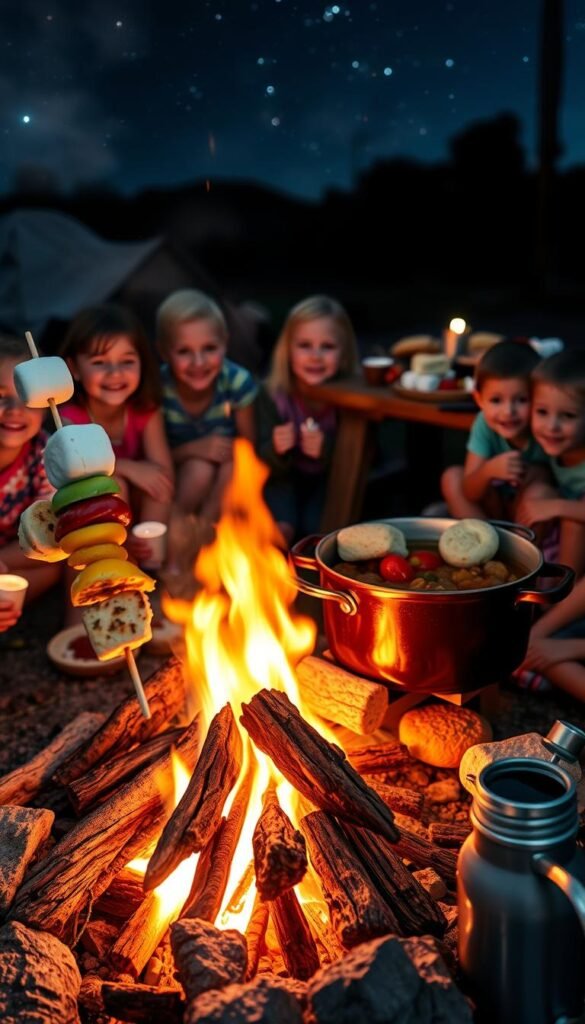
Set up a build-your-own station with small bowls of toppings: shredded cheese, pre-chopped peppers, and cooked ground turkey. Let kids assemble their meal in foil squares. They’ll love folding their creations into triangles or boats.
For campfire pizzas, pack pita bread or English muffins as bases. Kids can smear sauce with spoons and decorate with toppings. Pro tip: Use cookie cutters to shape pizzas into stars or animals—it keeps tiny chefs engaged.
Allergy-friendly swaps are simple. Try sunflower seed butter instead of peanut butter in banana boats. For s’mores alternatives, sandwich marshmallows between Rice Krispie treats or cinnamon graham crackers.
Portion control matters. I pre-measure ingredients in muffin tins—perfect for small appetites. Hide veggies by mixing finely grated zucchini into pizza sauce or carrots into foil packet nacho recipes.
These easy camping tricks turn mealtime into playtime. The best part? When kids create their own campfire feasts, they’re too proud to leave a single bite behind.
Please choose display type!Pairing Drinks with Campfire Meals
The right drink can elevate a simple campfire meal into something extraordinary—like finding the perfect harmony between flavors and memories. I discovered this during a lakeside trip, where strawberry lemonade cut through the richness of foil-wrapped nachos even better than I’d imagined. Whether it’s a crafted cocktail or a hydrating herbal brew, the perfect pairing turns food into an experience.
Jam Jar Cocktails
Mason jars aren’t just for preserves—they’re ideal for layered campfire drinks. Try this twist: Fill halfway with ice, add 2 oz bourbon, 1 tbsp orange marmalade, and top with ginger beer. The layers meld as you sip, creating evolving flavors.
Foraged infusion ideas:
- Pine needle syrup (steep young needles in simple syrup) for a woodsy gin fizz
- Blackberry-mint smash with muddled berries from the trail
- Smoked rosemary sprigs as garnish—hold over flames for 3 seconds
Non-Alcoholic Options
For summer mornings or family trips, mocktails shine. My go-to: Sparkling water with muddled basil, lime, and a drizzle of honey. Serve in enamel mugs to stay cool.
Hydration hacks for high-altitude trips:
- Add electrolyte tablets to herbal iced tea
- Freeze citrus slices in water bottles—they’ll thaw by mealtime
- Pair grilled corn with cucumber-mint infused water
Pro tip: Pre-mix drink recipes in labeled bags for your next camping trip. When the fire crackles and the stars emerge, you’ll have more time to savor both the meal and the moment.
Make-Ahead Tips for Faster Cooking
Smart prep turns campfire cooking from chore to joy—imagine unfolding a ready-to-cook feast after a long hike. I learned this after a rainy trip where pre-chopped veggies and marinated chicken saved dinner. Now, I swear by these time-saving hacks.
Frozen meal kits are game-changers. Assemble foil packets at home with proteins, veggies, and sauces. Label with cooking times (e.g., “20 mins medium coals”). Freeze flat to save cooler space. For dry ingredients, pre-mix spices or pancake batter in jars—just add water later.
Storage matters. Vacuum sealing locks in freshness for meats, while ziplock bags work for shorter trips. Here’s how they compare:
| Method | Best For | Prep Tip |
|---|---|---|
| Vacuum sealing | Long trips, raw meats | Pre-freeze liquids to avoid leaks |
| Ziplock bags | Weekend trips, dry mixes | Double-bag to prevent punctures |
Marinate proteins for 2–24 hours before freezing. Acidic sauces (like lemon-garlic) tenderize over time. For easy camping mornings, try pre-made Dutch oven cinnamon rolls—proof overnight near the fire.
Cool storage hacks: Nest prepped meals between ice packs in your cooler. Use frozen water bottles—they’ll thaw into drinks. Leftovers? Reheat foil packets on warm rocks near the fire’s edge. A little planning means more time for stargazing.
Common Mistakes to Avoid
Even seasoned outdoor chefs can stumble when flames dance unpredictably—I’ve lost count of foil packets sacrificed to rookie errors. That time in Yellowstone when wind flipped my grill grate? Lesson learned. Here’s how to dodge the pitfalls that turn campfire feasts into charcoal briquettes.
Fire management blunders top the list. Overcrowding the grate prevents even heat distribution—leave space between packets or skillet items. Source 3’s Dutch oven warning rings true: Coals should cover only two-thirds of the lid for steady 350°F heat.
Foil fails happen too. Standard thin sheets tear easily, releasing precious juices into the fire. Opt for these thicknesses:
| Foil Type | Best Use | Tip |
|---|---|---|
| Heavy-duty (18μm) | Meats, long cooking | Double-layer for fatty foods |
| Standard (12μm) | Veggies, short trips | Shiny side in for reflectivity |
Wind wrecks more meals than rain. Position a cast iron pan or rock wall as a windbreak—I use my cooler as a shield when gusts pick up. Always pack long-handled tongs; that blister from reaching over coals still tingles.
Underseasoning is the silent killer of wilderness meals. Proteins need 50% more spice outdoors—smoke mutes flavors. Pre-mix rubs in snack bags labeled by trip day. Forgot tools? A green stick makes a decent meat turner in a pinch.
Pro tip: Reseason your skillet after each use with oil and salt. That sticky breakfast scramble last summer? Likely from skipping this step. Now I keep a tiny oil bottle just for maintenance.
Most mistakes boil down to rushing. Take time to arrange coals properly, and your reward will be perfect grill marks—not a smoky SOS signal.
Conclusion
Some of my favorite travel stories start with a fork and a flickering flame. Gathering around the campfire transforms meals into shared adventures—where burnt marshmallows and perfect foil packets alike become legends.
Don’t fear experimentation. Tweak recipes to your taste, swap ingredients, or invent new combos. The great outdoors rewards creativity. For longer trips, prepping ahead saves precious time—leaving more moments for sunset views.
Pro tip: Jot down successful meals in a journal. Next camping trip, you’ll have a flavor roadmap. Share your wins with fellow adventurers—tag us with your fiery masterpieces!
Hungry for more? Our advanced guide dives into Dutch oven desserts and open-fire gourmet tricks. Until then, let the embers glow and the stories flow.
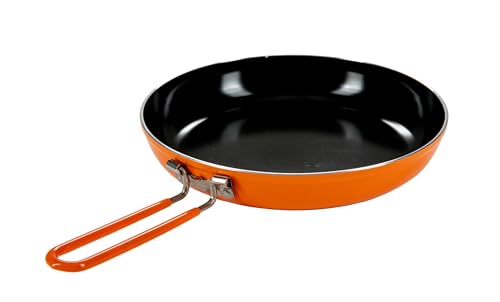


0 Comments